In This Issue
InFocus | Neutrino Oscillation: Daya Bay Collaboration Recognized
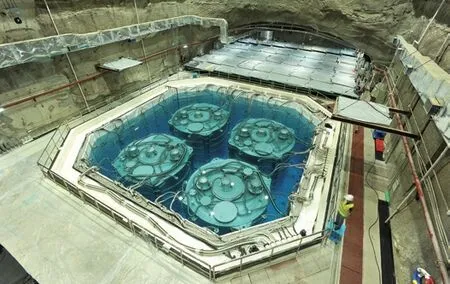
Antineutrino detectors submerged in water pools at the site of the Daya Bay experiment in Guangdong, China.(Image by IHEP)
China’s Daya Bay collaboration and the RENO collaboration of South Korea shared the 2023 High Energy and Particle Physics Prize of the European Physical Society(EPS) at a ceremony in Hamburg, Germany on August 21.The experiment discovered a new flavor of neutrino oscillation, and determined its mixing angle theta 13 (θ13) on March 8, 2012.The measurement was later confirmed by the RENO collaboration in South Korea.
The Daya Bay collaboration recently further updated their measurement to a much better accuracy.For detail, see page 138.
InFocus | Biggest Optical Time-domain Survey Telescope in Northern Hemisphere
With the release of a first-light image, a portrait of the Andromeda galaxy, the new Wide Field Survey Telescope (WFST),nicknamed Micius after an ancient philosopher of China, went into its official run on September 17.Located on the summit of Saishiteng Mountain over 4,200 meters above sea level, this 2.5-meter-aperture instrument marks the largest so far for optical time-domain survey in Northern Hemisphere, and is capable of surveying the whole northern sky in just three days.
For more, please turn to page 140.
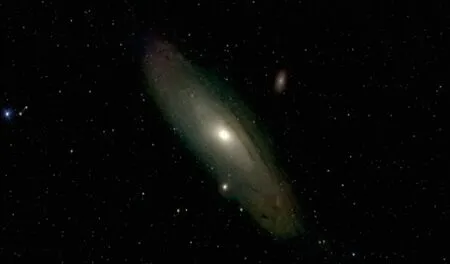
The newly launched Wide Field Survey Telescope(WFST), nick-named Micius survey telescope, releases its first-light image, a portrait of the Andromeda galaxy.(Image by USTC/PMO)
Scientists | Past and Now: How Our Ancestors Shaped Us

FU addresses the awarding ceremony.(Image: IVPP)
FU Qiaomei, a paleogeneticist at the Institute of Vertebrate Paleontology and Paleoanthropology (IVPP) of the Chinese Academy of Sciences (CAS), has been looking into the genetic history of human beings to understand where we have come from: what special linages of ancient human beings have contributed to our nowadays genetic map? Her long-term exploration into this labyrinth has earned her insights into the episodes of human evolution and, the recognition from the international community – she received the UNESCO-AI Fozan International Prized for the Promotion of Young Scientists in Science, Technology, Engineering and Mathematics (STEM) on June 19 in Paris, France.
Read more on page 143 for her story.
Highlights | Magnetically Arrested Disk: First Observational Evidence
Analyzing observational datasets from the same object obtained by instruments working in different wavebands – hard X-ray, radio and optical, an international team of astronomers successfully identified the first observational evidence for the formation of a magnetically arrested disk (MAD) in the accretion process of a black hole (BH) binary system.
The target binary contains a stellar-mass BH and a normal low-mass star orbiting the former.The BH keeps suck up matter from its companion star, and produces an accretion disk featuring hot plasm inflows.According to an accretion model,the inflow can strengthen the BH’s magnetic field until it is strong enough to counteract the BH’s own gravity to halt the accretion.In this case, the accretion matter would be “arrested” by the magnetic field to form a resting disk.This scenario, however, had never been captured by observational instruments, though the model predicts that binaries either dominated by a supermassive or stellar BH can produce such a MAD in their accretion process.
For detail how this has come true, please turn to page 147.
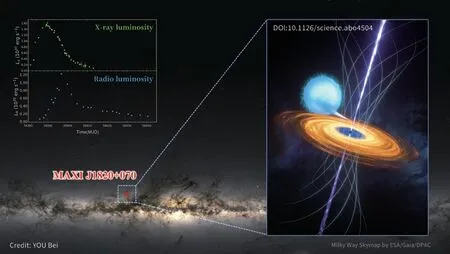
The team identified time lags between flares in different wavebands and interpreted them as evident formation of the MAD.(Image by YOU B)
Highlights | A Gel that Captures the “Cytokine Storm” Before It Strikes
For some cancer patients, the most dangerous part of a radically new treatment is not the tumor it targets but their own immune system.A therapy that genetically engineers T cells to wipe out malignancies can potentially incite cytokine storms – floods of inflammatory molecules that attack the body from within.Yet scientists from the National Center for Nanoscience and Technology (NCNST) of the Chinese Academy of Sciences have now developed a technique that averts these storms quietly and preemptively by capturing a key cytokine before it can rally the inflammatory troops against us.The technique relies on implanting an inconspicuous gel plug, or“cytokine sponge”, that acts as a molecular trap for runaway cytokines.
To delve into how this cytokine sponge works to capture the storm, please turn to page 150.
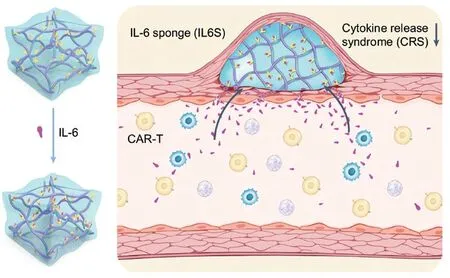
A gel trap for runaway cytokines that may cause fatal complications during a well-known cancer immunotherapy, namely CAR-T cell therapy.(Image by NCNST)
Highlights | Genome Surgery Made Simple with New Gene Editing Technique

An innovative technique, namely PAINT, can integrate new DNA sequences into cells with record efficiency and accuracy.(Image by Pixabay)
A new CRISPR-based technique developed by Chinese scientists enables highly efficient and accurate integration of new genes into cells, overcoming a major hurdle to realizing customized gene therapies.The method, called PAINT 3.0,attaches custom tails to donor DNA that seamlessly guide genes into place where the genome is cut.With its robust editing capabilities, this innovative genomic “surgery” method brings custom gene therapies closer to the clinic.
For further insights, please refer to page 152.
Highlights | Breaching Tumor Barriers with Help from Immune Cells
Scientists from University of Science and Technology of China (USTC) and the National University of Singapore have developed an innovative strategy to overcome a major obstacle to delivering cancer drugs: the tumor’s defensive barriers.By applying mild heat, they attracted immune cells called neutrophils to breach the tumor’s basement membrane barrier, creating openings that allowed trapped nanoparticles to penetrate deeply into tumors.This immune-assisted approach, published inNature Nanotechnologyon September 14, boosted nanoparticle drug delivery, and shrank tumors more effectively in mouse models.By leveraging the power of the immune system, this new method could vastly improve targeted cancer therapy outcomes.
For further insights, please refer to page 154.

Tumors have basement membrane barriers (purple) that block nanoparticle (gold) entry (a).Local mild heat recruits neutrophils(green) that infiltrate tumors by poking holes in barriers, enabling nanoparticle bursts into tumors (b).(Image by USTC)
Highlights | Tracing Cell Lineages with PhyloVelo
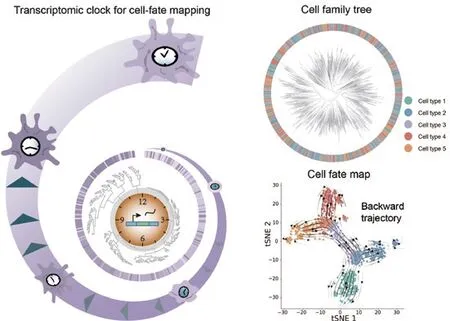
PhyloVelo, a new computational method that leverages monotonically expressed genes (MEGs) along cell divisions to quantify the transcriptomic velocity fields from lineage-resolved single-cell RNA-seq data, proves capable of mapping cellular journeys.(Credit: SIAT)
In a new study published inNature Biotechnologyon July 31, 2023, researchers at the CAS Shenzhen Institute of Advanced Technology (SIAT) and Xiamen University in China have developed a computational framework called PhyloVelo to reconstruct complex cell differentiation trajectories by integrating single-cell RNA sequencing and CRISPR-based lineage tracing.The method identifies monotonically expressed genes (MEGs) ticking like a clock along cell divisions to quantify transcriptomic changes.It accurately recovered known developmental lineages and provided new insights into surprising dedifferentiation processes during cancer progression.With its ability to map diverse cell journeys, PhyloVelo promises to illuminate normal development and disease mechanisms.
For further insights, please refer to page 156.
Highlights | Resolving the Genomic Roots of the Beloved Berry

Morphological features of F.chiloensis, F.virginiana, F.nipponica, and the cultivar ‘Camarosa’.Scale bar: 1 cm.(Credit: Nature Plants)
Sweet, juicy strawberries are one of the world’s most beloved fruits.But how did the modest wild berries of centuries past transform into the plump, flavorful varieties we enjoy today? The tangled genomic history underlying cultivated strawberry’s origins has long mystified scientists.Now, an international collaboration has cracked this genetic code.The related study was published inNature Plantson August 3, 2023.
For further insights, please refer to page 158.
Highlights | Mapping Circuit Linking Stress to Stomach Problems
Butterflies in your stomach?Turns out there’s a direct biological basis for how stress links emotions and the gut.New research inNature Metabolismmaps a brainto-stomach circuit regulating digestion – shedding light on why anxiety and depression often cause stomach troubles.Read on to learn how scientists traced this pathway in mice, what it means for treating gastrointestinal problems, and the ethical implications of manipulating brain-gut communication.
For more, please turn to page 160.

Male mice under chronic stress (living in a tilt cage and suffering from shallow water for 45 min and tail pinch for 15 min each day) are more likely to develop gastric dysfunction compared with unstressed ones.(Image by USTC)
Highlights | Solving Key Piece of Chromatin Assembly Puzzle
When cells divide, their DNA must be duplicated along with a protein scaffold called chromatin, so each new cell inherits a complete set of chromosomes.This intricate molecular dance depends on the flexible protein complex CAF-1, which grabs histones and deposits them onto newly copied DNA to assemble chromatin.But like a puzzle with missing pieces, the exact mechanism behind CAF-1’s architectural acrobatics has long mystified scientists.
As reported inScienceon August 25, researchers from the CAS Institute of Biophysics (IBP) have now solved crucial parts of the CAF-1 puzzle using high-resolution imaging techniques.Read on page 162 for insights into this intricate biological ballet that ensures the accurate transmission of genetic information when cells split into two.
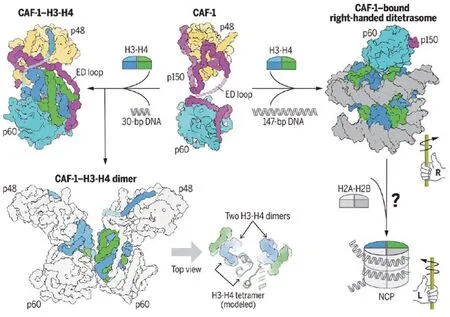
The structural snapshots provide molecular insights into how chromatin assembly factor-1 (CAF-1) marshals histones and DNA into proper chromatin structure during the intricate chromatin assembly process.(Credit: Science)
Highlights | Solving Key Piece of Chromatin Assembly Puzzle
Recent research reveals the delicate “dance” of molecular handoffs that guides cell maturation and specialization.In a study published inNature Geneticson September 4, 2023,scientists led by Dr.GAN Haiyun from the CAS Shenzhen Institute of Advanced Technology (SIAT) found that mice embryo development goes awry when the symmetric inheritance of histones occurs during cell divisions.
For further insights, please refer to page 164.
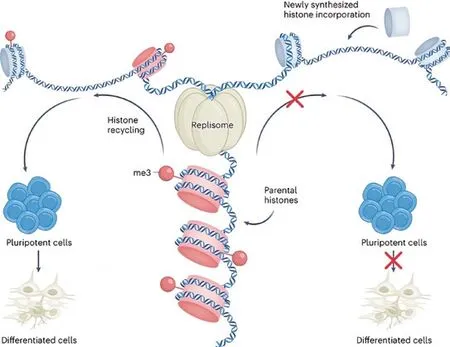
Perturbation of symmetric histone inheritance during DNA replication in embryonic stem cells negatively affects their differentiation capacity.(Image by Nature Genetics)
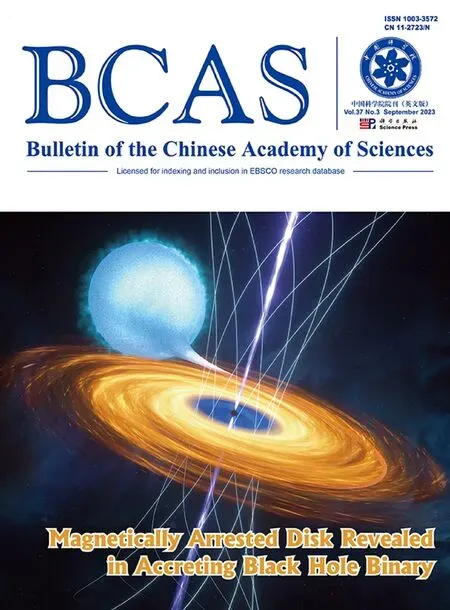 Bulletin of the Chinese Academy of Sciences2023年3期
Bulletin of the Chinese Academy of Sciences2023年3期
- Bulletin of the Chinese Academy of Sciences的其它文章
- Could Gut Bacteria Hold a Cure for Sepsis?
- Looking into the Tissue Adjacent to Tumors
- Daya Bay Collaboration Awarded 2023 High Energy and Particle Physics Prize by European Physical Society
- Largest Optical Time-domain Survey Telescope in Northern Hemisphere Goes into Operation
- CAS Paleogeneticist Awarded UNESCO Prize
- “Magnetically Arrested Disk”Revealed by Multiwavelength Observation
